display Citroen C5 2016 (RD/TD) / 2.G Owner's Guide
[x] Cancel search | Manufacturer: CITROEN, Model Year: 2016, Model line: C5, Model: Citroen C5 2016 (RD/TD) / 2.GPages: 366, PDF Size: 30.93 MB
Page 44 of 366
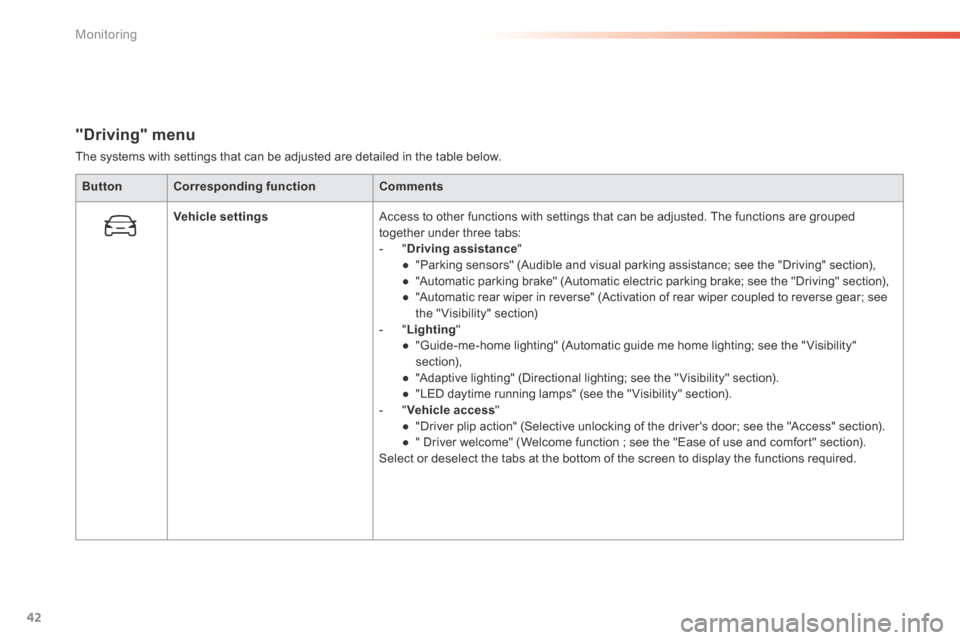
42
C5_en_Chap01_controle-de-marche_ed01-2015
"Driving" menu
The systems with settings that can be adjusted are detailed in the table below.Button Corresponding function Comments
Vehicle settings Access to other functions with settings that can be adjusted. The functions are grouped
together under three tabs:
- "Driving assistance "
● "Parking sensors" (Audible and visual parking assistance; see the "Driving" section),
● "Automatic parking brake" (Automatic electric parking brake; see the "Driving" section),
● "Automatic rear wiper in reverse" (Activation of rear wiper coupled to reverse gear; see
the " Visibility" section)
- " Lighting "
● "Guide-me-home lighting" (Automatic guide me home lighting; see the " Visibility"
section),
● "Adaptive lighting" (Directional lighting; see the " Visibility" section).
● "LED daytime running lamps" (see the " Visibility" section).
- " Vehicle access "
● "Driver plip action" (Selective unlocking of the driver's door; see the "Access" section).
● " Driver welcome" (Welcome function ; see the "Ease of use and comfort" section).
Select or deselect the tabs at the bottom of the screen to display the functions required.
Monitoring
Page 45 of 366
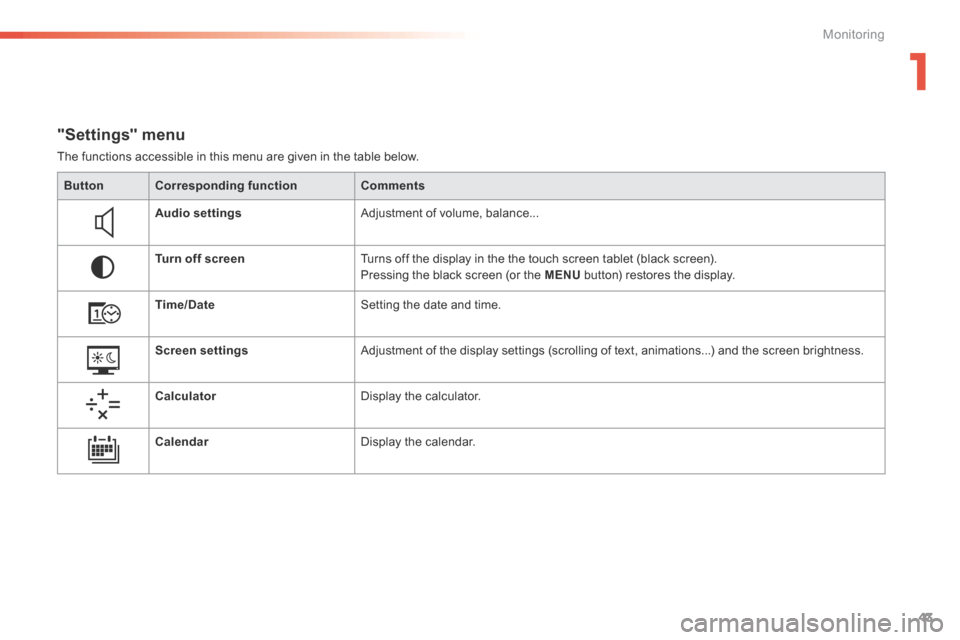
43
C5_en_Chap01_controle-de-marche_ed01-2015
"Settings" menu
The functions accessible in this menu are given in the table below.Button Corresponding function Comments
Audio settings Adjustment of volume, balance...
Turn off screen Turns off the display in the the touch screen tablet (black screen).
Pressing the black screen (or the MENU button) restores the display.
Time/Date Setting the date and time.
Screen settings Adjustment of the display settings (scrolling of text, animations...) and the screen brightness.
Calculator Display the calculator.
Calendar Display the calendar.
1
Monitoring
Page 76 of 366
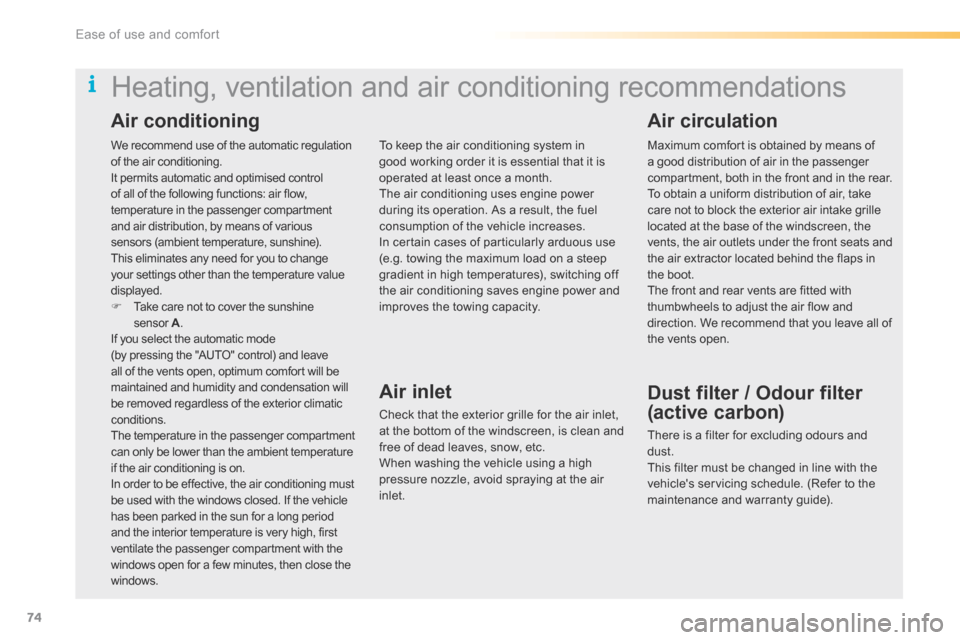
74
C5_en_Chap03_ergo-et-confort_ed01-2015
We recommend use of the automatic regulation
of the air conditioning.
It permits automatic and optimised control
of all of the following functions: air flow,
temperature in the passenger compartment
and air distribution, by means of various
sensors (ambient temperature, sunshine).
This eliminates any need for you to change
your settings other than the temperature value
displayed.
F Take care not to cover the sunshine
sensor A.
If you select the automatic mode
(by pressing the "AUTO" control) and leave
all of the vents open, optimum comfort will be
maintained and humidity and condensation will
be removed regardless of the exterior climatic
conditions.
The temperature in the passenger compartment
can only be lower than the ambient temperature
if the air conditioning is on.
In order to be effective, the air conditioning must
be used with the windows closed. If the vehicle
has been parked in the sun for a long period
and the interior temperature is very high, first
ventilate the passenger compartment with the
windows open for a few minutes, then close the
windows.
Heating, ventilation and air conditioning recommendations
To keep the air conditioning system in
good working order it is essential that it is
operated at least once a month.
The air conditioning uses engine power
during its operation. As a result, the fuel
consumption of the vehicle increases.
In certain cases of particularly arduous use
(e.g. towing the maximum load on a steep
gradient in high temperatures), switching off
the air conditioning saves engine power and
improves the towing capacity.
Air inlet
Check that the exterior grille for the air inlet,
at the bottom of the windscreen, is clean and
free of dead leaves, snow, etc.
When washing the vehicle using a high
pressure nozzle, avoid spraying at the air
inlet. Maximum comfort is obtained by means of
a good distribution of air in the passenger
compartment, both in the front and in the rear.
To obtain a uniform distribution of air, take
care not to block the exterior air intake grille
located at the base of the windscreen, the
vents, the air outlets under the front seats and
the air extractor located behind the flaps in
the boot.
The front and rear vents are fitted with
thumbwheels to adjust the air flow and
direction. We recommend that you leave all of
the vents open.
Dust filter / Odour filter
(active carbon)
There is a filter for excluding odours and
dust.
This filter must be changed in line with the
vehicle's servicing schedule. (Refer to the
maintenance and warranty guide).
Air conditioning
Air circulation
Ease of use and comfort
Page 77 of 366
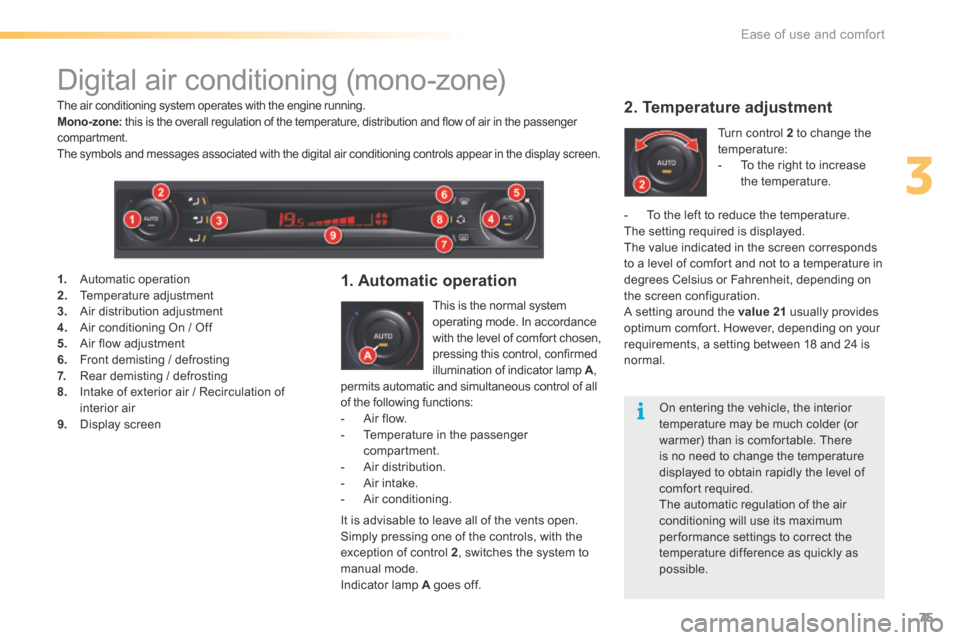
75
C5_en_Chap03_ergo-et-confort_ed01-2015
Digital air conditioning (mono-zone)
This is the normal system
operating mode. In accordance
with the level of comfor t chosen,
pressing this control, confirmed
illumination of indicator lamp A,
permits automatic and simultaneous control of all
of the following functions:
- Air flow.
- Temperature in the passenger
compartment.
- Air distribution.
- Air intake.
- Air conditioning.
1. Automatic operation
It is advisable to leave all of the vents open.
Simply pressing one of the controls, with the
exception of control 2 , switches the system to
manual mode.
Indicator lamp A goes off.
2. Temperature adjustment
Turn control 2 to change the
temperature:
- To the right to increase
the temperature.
1. Automatic operation
2. Temperature adjustment
3. Air distribution adjustment
4. Air conditioning On / Off
5. Air flow adjustment
6. Front demisting / defrosting
7. Rear demisting / defrosting
8. Intake of exterior air / Recirculation of
interior air
9. d isplay screen -
To the left to reduce the temperature.
The setting required is displayed.
The value indicated in the screen corresponds
to a level of comfort and not to a temperature in
degrees Celsius or Fahrenheit, depending on
the screen configuration.
A setting around the value 21 usually provides
optimum comfort. However, depending on your
requirements, a setting between 18 and 24 is
normal.
The air conditioning system operates with the engine running.
Mono-zone: this is the overall regulation of the temperature, distribution and flow of air in the passenger
compartment.
The symbols and messages associated with the digital air conditioning controls appear in the display screen.
On entering the vehicle, the interior
temperature may be much colder (or
warmer) than is comfortable. There
is no need to change the temperature
displayed to obtain rapidly the level of
comfort required.
The automatic regulation of the air
conditioning will use its maximum
per formance settings to correct the
temperature difference as quickly as
possible.
3
Ease of use and comfort
Page 78 of 366

76
C5_en_Chap03_ergo-et-confort_ed01-2015
Control via the manual controls
It is possible to adjust one or more functions
manually, while leaving the other functions in
automatic mode.
F Press one of the controls, with the
exception of the one that regulates the
temperature 2. Indicator lamp A goes off.
Switching to manual mode may result in
discomfort (temperature, humidity, odour,
condensation) and may not provide optimum
comfort.
To return to automatic mode, press the "AUTO"
control.
3. Air distribution adjustment
F Press the controls 3 to
change the distribution of the
air flow.
4. Air conditioning
F Press control 4 . Indicator
lamp B comes on.
In order to be effective, the air conditioning
must be used with the windows closed.
Deactivating the air conditioning may result
in discomfort (temperature, humidity, odour,
condensation).
The indicator lamps corresponding to the
distribution chosen come on:
-
Windscreen and front side windows.
- Front ventilation (central and side vents
and air diffusion grille if open) and rear
ventilation.
- Front and rear footwells. The air conditioning will only operate when the
engine is running. The air blower control (air
flow adjustment) must be active to obtain air
conditioning.
Simultaneous display of the distribution of
air to the windscreen and side windows and
of front and rear ventilation is not possible.
Ease of use and comfort
Page 79 of 366

77
C5_en_Chap03_ergo-et-confort_ed01-2015
With Stop & Start, when demisting has
been activated, the STOP mode is not
available.
Switching off the ventilation
F Turn control 5 to the left until
the flow of air stops.
5. Air flow adjustment
F Turn control 5 to the right to
increase the air flow or to the
left to reduce it.
6. Front demisting / defrosting
In certain cases, the "AUTO"
mode may not be sufficient to
demist or defrost the windows
(humidity, several passengers,
i c e).
The "OFF" symbol is displayed in the display screen.
This action switches off the screen and the indicator
lamps.
It deactivates all of the system's functions, with the
exception of the rear screen demisting.
The temperature-related comfort is no longer controlled
(temperature, humidity, odour, condensation).
Avoid driving for too long with the air conditioning off.The air flow level is indicated by the
progressive illumination of the bars in the
control panel screen 9 .
To prevent condensation and deterioration
of the quality of the air in the passenger
compartment, ensure that an adequate flow of
air is maintained.
To reactivate the air conditioning:
F Press control 1 . F
Press control 6 to clear the windows
quickly. The indicator lamp comes on.
The "Demisting" mode controls the
temperature, air flow and intake and distributes
the ventilation to the windscreen and front side
windows.
Resuming manual control exits from
"Demisting" mode. It must be cancelled to
permit renewal of the air in the passenger
compartment and demisting.
Once the screen is clear, pressing control 1
returns the system to "AUTO" mode.
3
Ease of use and comfort
Page 80 of 366
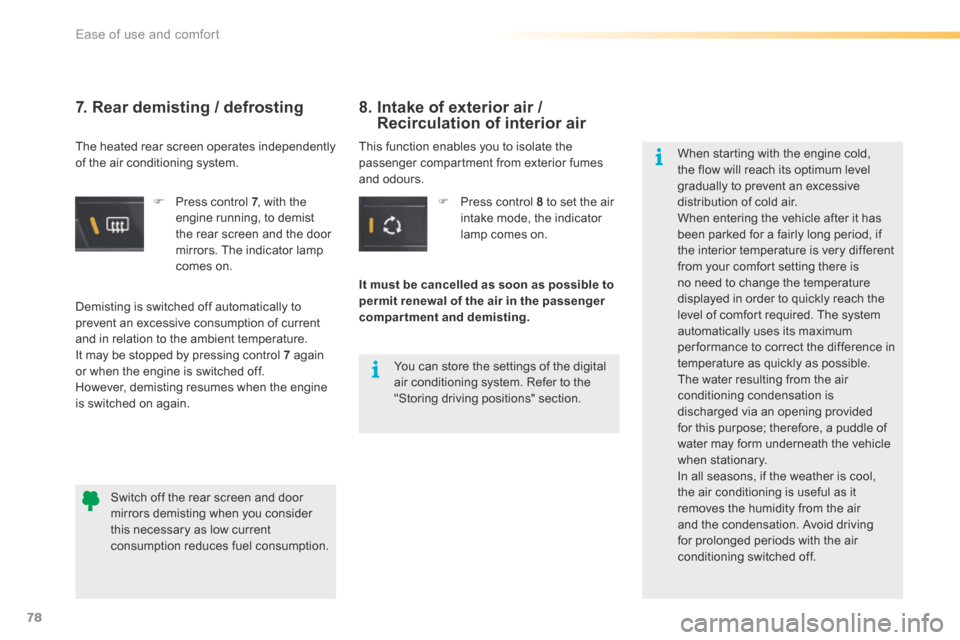
78
C5_en_Chap03_ergo-et-confort_ed01-2015
F Press control 7 , with the
engine running, to demist
the rear screen and the door
mirrors. The indicator lamp
comes on.
7. Rear demisting / defrosting
This function enables you to isolate the
passenger compartment from exterior fumes
and odours.
Switch off the rear screen and door
mirrors demisting when you consider
this necessary as low current
consumption reduces fuel consumption. F
Press control 8 to set the air
intake mode, the indicator
lamp comes on.
Demisting is switched off automatically to
prevent an excessive consumption of current
and in relation to the ambient temperature.
It may be stopped by pressing control 7 again
or when the engine is switched off.
However, demisting resumes when the engine
is switched on again. It must be cancelled as soon as possible to
permit renewal of the air in the passenger
compartment and demisting.
The heated rear screen operates independently
of the air conditioning system.
You can store the settings of the digital
air conditioning system. Refer to the
"Storing driving positions" section.When starting with the engine cold,
the flow will reach its optimum level
gradually to prevent an excessive
distribution of cold air.
When entering the vehicle after it has
been parked for a fairly long period, if
the interior temperature is very different
from your comfort setting there is
no need to change the temperature
displayed in order to quickly reach the
level of comfort required. The system
automatically uses its maximum
per formance to correct the difference in
temperature as quickly as possible.
The water resulting from the air
conditioning condensation is
discharged via an opening provided
for this purpose; therefore, a puddle of
water may form underneath the vehicle
when stationary.
In all seasons, if the weather is cool,
the air conditioning is useful as it
removes the humidity from the air
and the condensation. Avoid driving
for prolonged periods with the air
conditioning switched off.
8.
Intake of exterior air /
Recirculation of interior air
Ease of use and comfort
Page 81 of 366

79
C5_en_Chap03_ergo-et-confort_ed01-2015
Digital air conditioning (dual-zone)
The air conditioning system operates with the engine running.
Dual-zone: this is the independent regulation of the temperature and air distribution on the driver's
side and the front passenger's side.
The driver and front passenger can each adjust the temperature and the distribution of the air to
suit their requirements.
The symbols and messages associated with the digital air conditioning controls appear in the
display screen. This is the normal system
operating mode. In accordance
with the level of comfort chosen,
pressing this control, confirmed
by illumination of indicator
lamp
A, permits automatic and
simultaneous control of all of the
following functions:1a-1b. Automatic operation
1a. Automatic operation on the driver's side
1b. Automatic operation on the passenger's
side
2a. Temperature adjustment on the driver's side
2b. Temperature adjustment on the
passenger's side
3a. Air distribution adjustment on the driver's
side
3b. Air distribution adjustment on the
passenger's side 4a.
Driver's zone screen
4b. Passenger's zone screen
5. Air flow adjustment
6. Air conditioning On / Off
7. Intake of exterior air / Recirculation of interior
air
8. Rear demisting / defrosting
9. Front demisting / defrosting -
Air flow.
- Temperature in the passenger
compartment.
- Air distribution.
- Air conditioning.
- Automatic air recirculation.
It is advisable to leave all of the vents open.
Simply pressing one of the controls, with the
exception of temperature regulation 2a and 2b,
switches the system to manual mode. Indicator
lamp A goes off.
3
Ease of use and comfort
Page 82 of 366

80
C5_en_Chap03_ergo-et-confort_ed01-2015
2a-2b. Temperature adjustmentControl via the manual
controls3a-3b.
Air distribution
adjustment
F Press control 3b to change the distribution
of the air flow on the passenger's side.
The indicator lamps corresponding to the
distribution chosen come on:
- Windscreen and front side windows.
- Front ventilation (central and side vents
and air diffusion grille if open) and rear
ventilation.
- Front and rear footwells.
F
Turn control 2a to change the temperature
on the driver's side and control 2b
to change the temperature on the
passenger's side: to the right to increase or
to the left to reduce it.
The setting required is displayed.
The value indicated on the display corresponds
to a level of comfort and not to a temperature in
degrees Celsius or Fahrenheit, depending on
the screen configuration.
A setting around the value 21 usually provides
optimum comfort. However, depending on your
requirements, a setting between 18 and 24 is
normal. F
Press control 3a
to change the
distribution of the
air flow on the
driver's side.
F Press one of the controls, with the
exception of temperature regulation 2a and
2b . The indicator lamps A in the "AUTO"
controls go off.
It is possible to adjust one or more functions
manually while leaving the other functions in
automatic mode.
Switching to manual mode may result in discomfor t
(temperature, humidity, odour, condensation) and
may not provide optimum comfort.
To return to "AUTO" mode, press controls 1a
and 1b . The indicator lamps A come on.
On entering the vehicle, the interior
temperature may be much colder (or
warmer) than is comfortable. There
is no need to change the temperature
displayed in order to quickly obtain the
level of comfort required.
The automatic regulation of the air
conditioning will use its maximum
per formance settings to correct the
temperature difference as quickly as
possible.
Simultaneous display of the
distribution of air to the windscreen
and side windows and of front and rear
ventilation is not possible.
Ease of use and comfort
Page 84 of 366
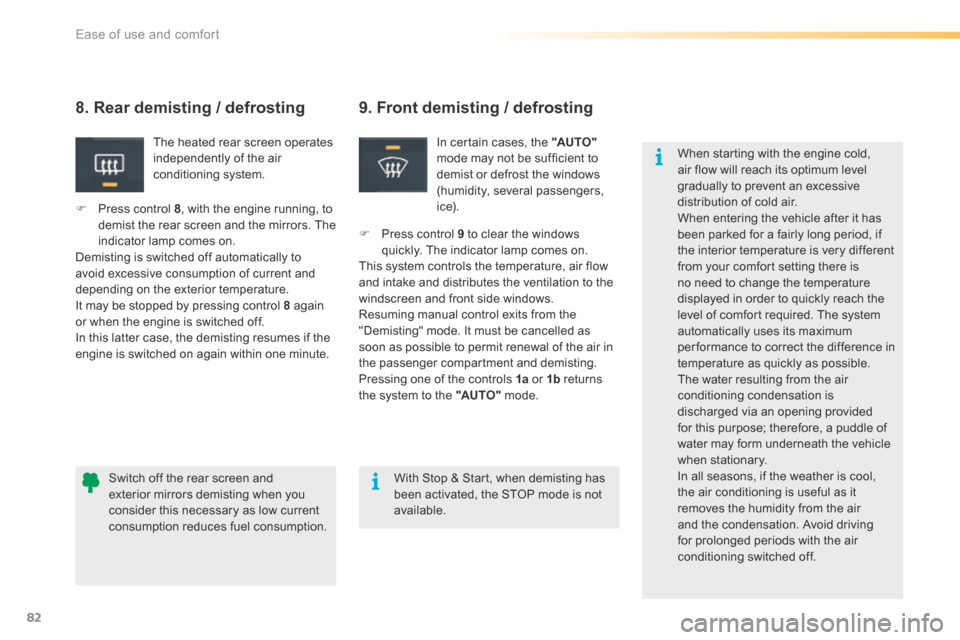
82
C5_en_Chap03_ergo-et-confort_ed01-2015
9. Front demisting / defrosting
In certain cases, the "AUTO"
mode may not be sufficient to
demist or defrost the windows
(humidity, several passengers,
i c e).
8. Rear demisting / defrosting
The heated rear screen operates
independently of the air
conditioning system.
F Press control 8 , with the engine running, to
demist the rear screen and the mirrors. The
indicator lamp comes on.
Demisting is switched off automatically to
avoid excessive consumption of current and
depending on the exterior temperature.
It may be stopped by pressing control 8 again
or when the engine is switched off.
In this latter case, the demisting resumes if the
engine is switched on again within one minute. F
Press control 9 to clear the windows
quickly. The indicator lamp comes on.
This system controls the temperature, air flow
and intake and distributes the ventilation to the
windscreen and front side windows.
Resuming manual control exits from the
"Demisting" mode. It must be cancelled as
soon as possible to permit renewal of the air in
the passenger compartment and demisting.
Pressing one of the controls 1a or 1b returns
the system to the "AUTO" mode.
With Stop & Start, when demisting has
been activated, the STOP mode is not
available. When starting with the engine cold,
air flow will reach its optimum level
gradually to prevent an excessive
distribution of cold air.
When entering the vehicle after it has
been parked for a fairly long period, if
the interior temperature is very different
from your comfort setting there is
no need to change the temperature
displayed in order to quickly reach the
level of comfort required. The system
automatically uses its maximum
per formance to correct the difference in
temperature as quickly as possible.
The water resulting from the air
conditioning condensation is
discharged via an opening provided
for this purpose; therefore, a puddle of
water may form underneath the vehicle
when stationary.
In all seasons, if the weather is cool,
the air conditioning is useful as it
removes the humidity from the air
and the condensation. Avoid driving
for prolonged periods with the air
conditioning switched off.
Switch off the rear screen and
exterior mirrors demisting when you
consider this necessary as low current
consumption reduces fuel consumption.
Ease of use and comfort